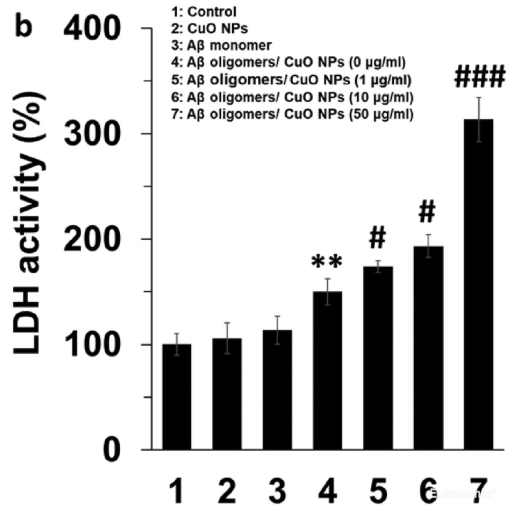Lactate Dehydrogenase (LDH) Activity Assay Kit
SKU: E-BC-K046-M-500
Lactate Dehydrogenase (LDH) Activity Assay Kit
| SKU # | E-BC-K046-M |
| Detection Instrument | Microplate reader(440-460 nm, optimum wavelength: 450 nm) |
| Detection Method | Colorimetric method |
Product Details
Properties
| Synonyms | LDH |
| Sample Type | Serum, plasma, hydrothorax, tissue, cells |
| Sensitivity | 6 U/L |
| Detection Range | 6-1000 U/L |
| Detection Method | Colorimetric method |
| Assay type | Enzyme Activity |
| Assay time | 45 min |
| Precision | Average inter-assay CV: 2.400% | Average intra-assay CV: 1.800% |
| Other instruments required | Micropipettor, Multichannel pipette, Incubator |
| Other reagents required | Normal saline (0.9% NaCl), PBS (0.01 M, pH 7.4) |
| Storage | 2-8℃ |
| Valid period | 12 months |
Images
L A Jaragh-Alhadad et al investigates the neurotoxicity of copper oxide that may promote Alzheimer’s diseases. Lactate Dehydrogenase (LDH) activity of human cell was determined using LDH activity assay kit (E-BC-K046-M).

The activity of LDH that shows the membrane leakage was significantly increased after treating with CuO. (**P<0.01 vs. Control, #P<0.05, ###P<0.001 vs. untreated group)
Detection Principle
Using coenzyme I as a hydrogen carrier, LDH catalyze lactic acid to produce pyruvate. Pyruvate reacted with 2, 4-dinitrophenylhydrazine to form pyruvate dinitrophenylhydrazone, which was red-brown in alkaline solution, and the color depth was proportional to pyruvate concentration. The activity of LDH could be calculated by measuring OD value.
Kit Components & Storage
| Item | Component | Size (96 T) | Storage |
| Reagent 1 | Substrate Buffer | 5 mL × 1 vial | 2-8°C, 12 months |
| Reagent 2 | Coenzyme I | Powder × 1 vial | 2-8°C, 12 months |
| Reagent 3 | Chromogenic Agent | 5 mL × 1 vial | 2-8°C, 12 months, shading light |
| Reagent 4 | Alkali Reagent | 5 mL × 1 vial | 2-8°C, 12 months |
| Reagent 5 | 2 µmol/mL Pyruvic Acid Standard | 1 mL × 1 vial | 2-8°C, 12 months |
| Microplate | 96 wells | No requirement | |
| Plate Sealer | 2 pieces |
Note: The reagents must be stored strictly according to the preservation conditions in the above table. The reagents in different kits cannot be mixed with each other. For a small volume of reagents, please centrifuge before use, so as not to obtain sufficient amount of reagents.
Technical Data:
Parameter:
Intra-assay Precision
Three human serum samples were assayed in replicates of 20 to determine precision within an assay (CV = Coefficient of Variation).
| Parameters | Sample 1 | Sample 2 | Sample 3 |
| Mean (U/L) | 14.50 | 250.00 | 662.00 |
| %CV | 2.3 | 1.6 | 1.5 |
Inter-assay Precision
Three human serum samples were assayed 20 times in duplicate by three operators to determine precision between assays.
| Parameters | Sample 1 | Sample 2 | Sample 3 |
| Mean (U/L) | 14.50 | 250.00 | 662.00 |
| %CV | 2.2 | 2.4 | 2.6 |
Recovery
Take three samples of high concentration, middle concentration and low concentration to test the samples of each concentration for 6 times parallelly to get the average recovery rate of 98%.
| Standard 1 | Standard 2 | Standard 3 | |
| Expected Conc. (μmol/L) | 0.08 | 0.24 | 0.76 |
| Observed Conc. (μmol/L) | 0.1 | 0.2 | 0.7 |
| Recovery rate (%) | 98 | 99 | 97 |
Sensitivity
The analytical sensitivity of the assay is 6 U/L. This was determined by adding two standard deviations to the mean O.D. obtained when the zero standard was assayed 20 times, and calculating the corresponding concentration.
Standard Curve:
As the OD value of the standard curve may vary according to the conditions of the actual assay performance (e.g. operator, pipetting technique or temperature effects), so the standard curve and data are provided as below for reference only:
| Concentration (μmol/L) | 0 | 0.05 | 0.1 | 0.2 | 0.4 | 0.6 | 0.8 | 1 |
| Average OD | 0.091 | 0.131 | 0.175 | 0.257 | 0.408 | 0.557 | 0.712 | 0.844 |
| Absoluted OD | 0.000 | 0.04 | 0.084 | 0.166 | 0.317 | 0.466 | 0.621 | 0.753 |



